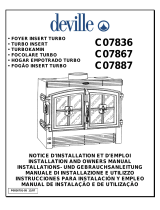
4 20000706
The firescreen is a protective curtain of wire mesh that
helps keep sparks and hot embers from leaving the
firebox. The firescreen should always be kept closed
whenever a fire is burning in the firebox.
Your fireplace may also include many of the following
energy efficient components that provide additional
heat output and efficient home operation:
Heat-Circulation adds to the standard radiant heat
output of a traditional fireplace by distributing useful
amounts of convective heat into the home. Heat-circu-
lating fireplaces circulate cool room air around the hot
firebox where it is warmed and returned to the room as
beneficial heat. The BC, BCMH, TL, SC, WMC, BFC
and EWF Series fireplace models feature heat circula-
tion.
The Heat Exchanger is a multiple wall construction
that directs room air around the firebox and back into
the room of a heat-circulating fireplace system. Heat
transfer from the hot fire to the circulating room air oc-
curs through these passageways. The heat exchanger
is the heart of a heat-circulating system which provides
the extra room heat that is lost with conventional fire-
places.
The Air Inlet/Outlet Grilles are part of the heat-circula-
tion system. Cool room air enters through the bottom
grille and/or lower side inlet grilles and travels through
the heat exchanger passageways. The resulting hot air
is then returned to the room through the upper outlet
grille.
NOTE: Air inlet/outlet grilles should never be cov-
ered or blocked off. The heat-circulation system
is also used as fireplace cooling system for safe
operation.
Outside Combustion Air: A fire requires a sufficient
amount of air in order to burn properly. Insufficient air
will cause smoking, sooting and harmful gases to filter
out of the fireplace into the room. As the fire burns in
the firebox, replacement air enters the firebox opening
from the room to make up the loss of combustion air.
Often tightly sealed and well insulated homes do not
provide sufficient amounts of air for this natural replace-
ment process. To maintain a constant flow of combus-
tion air, direct outside air may be needed.
CFM Corporation fireplaces are designed with outside
air capabilities which supply outside combustion air
directly to the firebox. The air system requires ducting
from fireplace to an outside air source at time of original
installation. The WMC, BR, BC, BCMH, TF, TL, CR, SC,
SHR, ODSHR, TSH, SR, ODSR, STR, TST and CVR
Series fireplaces offer this feature as standard equip-
ment. The BFC fireplace includes integral outside air
and no additional ducting is necessary.
If your fireplace is equipped with outside air, the control
lever will be located at the front edge of the left side
brick on the BR, TF, SR, ODSR, WMC, STR and TST
Series. On the CR Series fireplaces, it is located at the
lower left or right corner of the air inlet. On the SHR,
ODSHR and TSH Series, the control lever is located in
the center, just above the left side brick. Refer to Page
6 for proper operation procedure.
Primary Air Control: On the EWF Series fireplace, the
primary air control regulates the amount of heat the fire
will produce and how long it will burn. The primary air
control is located in the upper left corner of the unit. It
is the primary source of air for starting, maintaining and
reviving the fire.
The air supply is open to the maximum when the control
lever is rotated clockwise on the EWF36A or pushed
down on the EWF30 and closed when rotated counter-
clockwise on the EWF36A or pushed up on the EWF30.
To vary the burn rate, adjust the control to the desired
position in between these extremes; opening the
primary air control makes the unit burn hotter. Closing
the control slows the unit down. You can adjust to any
position you desire.
Glass Doors improve fireplace efficiency to help save
home energy. When firing a fireplace, the need for
combustion air draws room air into the firebox where it
mixes with the hot flue gases and then is expelled up
the open flue. The loss of preheated room air is most
significant when burning a low intensive fire which
normally occurs during start-up and shutdown of the
fireplace. CFM Corporation glass doors are specially
designed to reduce the amount of heated room air
loss and, at the same time, allow the proper amount
of combustion air to be filtered into the firebox for safe
operation.
When using glass doors on a heat-circulating fireplace,
the controlled combustion air also intensifies the heat
exchanger temperature and slows the fuel burning rate.
The result is maximum heating while using the least
amount of fuel. Glass doors are standard equipment on
WMC, BFC and EWF Series fireplaces and are offered
as optional accessories for all other CFM Corporation
fireplace models. Refer to proper operation procedures
on Page 6 and 7.
Forced Air Circulation: Heat-circulating fireplaces use
the natural process of hot air rising to distribute heat
from the fireplace to the room. This principle is suffi-
cient for small room application. To distribute a constant
flow of warm air further into a larger room, forced air
fans are recommended. To determine if the fireplace is
equipped with fans, use a flashlight and look through
the lower inlet air grille. CFM Corporation offers optional
fan kits for all heat-circulating models. For easy installa-
tion of an optional fan kit, the fireplace should be wired















